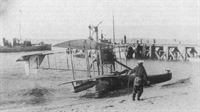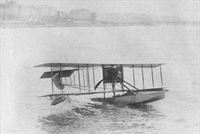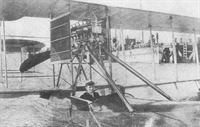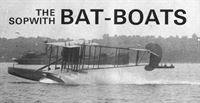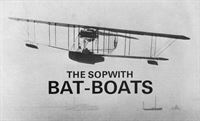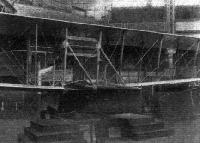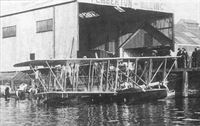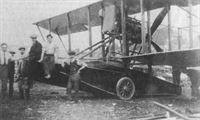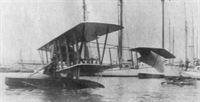
Sopwith Batboat
Первой из известных разработок компании "Sopwith" стала летающая лодка Batboat с толкающим винтом, построенная в 1913 году. Первые два самолета имели корпус, изготовленный по технологии "Consuta" (сшитая проволокой фанера) судостроительной фирмой "S. Е. Saunders boat company", к которому крепилось нижнее крыло.
Первая машина была оснащена 90-сильным (67 кВт) ПД Austro-Daimler, и в феврале 1913 года ее купило британское Адмиралтейство. Самолет проходил испытания в Калшоте, но получил серьезные повреждения при аварии, позднее он был отремонтирован.
Второй Batboat был оснащен 100-сильным (75 кВт) ПД Green и 8 июля 1913 года выиграл состязания "Mortimer Singer".
Проведенные ВМС испытания заставили доработать конструкцию Batboat, сделав его более подходящим для военной службы. В 1914 году "Sopwith" построила вторую партию машин. Оснащенные 200-сильным (149 кВт) ПД Canton-Unne, они отличались увеличенными размерами - размах крыла возрос до 16,76 м, а максимальная масса до 1043 кг. Самолет мог находиться в воздухе четыре с половиной часа, а радиус действия составлял 290 км.
Первый из этих самолетов был испытан Королевскими ВМС в Калшоте, но на вооружение его не приняли, продав в июле 1914 года Греции. Второй самолет был куплен Германией. Он базировался в Киль-Холтенау и использовался для учебных целей.
Пятый Batboat был построен для гонок "Circuit of Britain" 1914 года, но это состязание отменили из-за начавшейся войны. Самолет был реквизирован Королевскими ВМС и эксплуатировался до апреля 1915 года.
- Описание
Фотографии
-
Aeroplane Monthly 1991-08 / J.Bruce - The Sopwith Bat-Boats (1)
These photographs bear no identity, place or date, but are known to have had a connection with the late Sir Thomas Sopwith. The aircraft conforms so closely with the description given in The Aeroplane of August 1, 1912, that it is very probably the first of all the Sopwith Bat-Boats, built that summer. Note the resemblance to the Donnet-Leveque. Although the Gnome engine and propeller were in place when these pictures were taken, it remains unknown whether any attempt was ever made to fly the aircraft.
-
Aeroplane Monthly 1991-08 / J.Bruce - The Sopwith Bat-Boats (1)
The first 1913 Bat Boat on the Sopwith stand at that year's Olympia Aero Show. The photograph illustrates the forward elevator, the warp ng wings and the inevitable absence of cross-bracing between the outermost interplane struts.
-
Aeroplane Monthly 1991-08 / J.Bruce - The Sopwith Bat-Boats (1)
The first Sopwith Bat-Boat to have the 90 h.p. Austro-Daimler engine is seen here being assembled, early in 1913, in the abandoned roller-skating rink that Tom Sopwith acquired as his first factory in Kingston-upon-Thames.
-
Мировая Авиация 239
Самолеты Batboat были первыми летающими лодками, построенными в Великобритании. Несколько из них несли службу в авиации британских ВМС в начале Первой мировой войны.
-
Aeroplane Monthly 1991-09 / J.Bruce - The Sopwith Bat-Boats (2)
Bat Boat in ‘Singer’ configuration; twin fins and rudders, 100hp Green, amphibious undercarriage and revised wing floats.
The twin-boom Bat-Boat in the form in which it won the Mortimer Singer prize, with a 100 h.p. Green engine replacing the Austro-Daimler. -
Aeroplane Monthly 1991-09 / J.Bruce - The Sopwith Bat-Boats (2)
This photograph of the amphibious twin-rudder Bat-Boat that won the Mortimer Singer prize on July 8, 1913, was taken at Folly. As the engine appears to be an Austro-Daimler driving a Levasseur propeller, this may be an early photograph. Features of this historic aircraft were its ailerons, one-piece elevator and its landing wheels, seen here in the raised position. At this time there were no interplane struts between the forward ends of the tailbooms.
-
Aeroplane Monthly 1991-09 / J.Bruce - The Sopwith Bat-Boats (2)
The Mortimer Singer Bat-Boat later went to the Naval Wing of the RFC with its wheels removed and its Austro-Daimler engine reinstated. It is seen here at Calshot Naval Air Station with its serial number 118 on the rudders. Also noteworthy are the twin fixed fins that had been fitted by May 18, 1914, and the CAV headlight that was first tried out in a night flight made by Lt A. W. Bigs worth RN on June 25.
-
Aeroplane Monthly 1991-09 / J.Bruce - The Sopwith Bat-Boats (2)
This single-rudder Bat-Boat was the first to serve with the Naval Wing and must have been the first to be allotted the serial number 38, a marking that was never painted on. Here it is seen off Netley on August 16, 1913.
-
Aeroplane Monthly 1991-09 / J.Bruce - The Sopwith Bat-Boats (2)
The Naval Wing’s first Bat-Boat after its arrival at Brighton on August 23, 1913. Moored out overnight, it was found to be sinking next morning, and well-intentioned efforts to bring it ashore only brought about its destruction.
-
Aeroplane Monthly 1991-08 / J.Bruce - The Sopwith Bat-Boats (1)
The second Sopwith Bat-Boat, powered by a 90 h.p. Austro-Daimler.
-
Aeroplane Monthly 1991-09 / J.Bruce - The Sopwith Bat-Boats (2)
In this closer view of No 118 the starboard bearing for the shaft that had carried the landing wheels may be seen on the hull side immediately below the elevator actuating lever. The engine had no vestige of cowling or fairing and was flanked by two large radiator surfaces, and interplane struts had been fitted between the points where the tailbooms met the rear spars.
-
Aeroplane Monthly 1991-09 / J.Bruce - The Sopwith Bat-Boats (2)
Presumably taken shortly after the original No 38 was delivered to the Naval Wing, this photograph clearly illustrates the side-by-side positions of the crew.
-
Aeroplane Monthly 1991-10 / J.Bruce - The Sopwith Bat-Boats (3)
An Austro-Daimler-powered Bat-Boat takes off.
-
Aeroplane Monthly 1991-10 / J.Bruce - The Sopwith Bat-Boats (3)
The Austro-Daimler-powered Bat-Boat which visibly wore the number 38 was delivered just before the Admiralty redesignated the RFC's Naval Wing as the Royal Naval Air Service, it is seen here in early August 1914 at Felixstowe, where it was briefly stationed before going north to Scapa Flow.
-
Aeroplane Monthly 1991-09 / J.Bruce - The Sopwith Bat-Boats (2)
A relatively rare shot of a Salmson (Canton-Unne)-powered Bat-Boat in flight.
Sopwith Bat Boat with original form with single fin and rudder, powered by the 90hp (67kW) Austro-Daimler. -
Aeroplane Monthly 1991-10 / J.Bruce - The Sopwith Bat-Boats (3)
The Sopwith company’s impressive exhibit at the 1914 Olympia Aero Show, which opened on March 16, was this Bat-Boat of the larger type, fitted with a 200 h.p. Salmson (Canton-Unne) water-cooled radial engine.
-
Flight 1935-05 / Flight
The Sopwith "Bat Boat" exhibited at Olympia in 1914 was one of the earliest British flying boats. The engine was a 200 h.p. Salmson Canton-Unne 14-cyl. water-cooled radial.
-
Aeroplane Monthly 1991-10 / J.Bruce - The Sopwith Bat-Boats (3)
One of the Salmson-powered Bat-Boats beside the Pemberton-Billing shed at Woolston.
-
Aeroplane Monthly 1991-10 / J.Bruce - The Sopwith Bat-Boats (3)
The other known Salmson-powered Bat-Boat was purchased by Germany. It was flown to that country in late May 1914 by Wilhelm Hillman and was given the German naval serial 44.
-
Aeroplane Monthly 1991-10 / J.Bruce - The Sopwith Bat-Boats (3)
This Sunbeam powered Bat-Boat, one of two Sopwith aircraft entered for the 1914 Circuit of Britain seaplane contest, was photographed at Woolston. To provide clearance for the Sunbeam’s large four-bladed propeller, the wings had to be raised above the hull to the extent seen here.
-
Aeroplane Monthly 1991-10 / J.Bruce - The Sopwith Bat-Boats (3)
As neither this photograph (taken at Woolston) nor the one at right (taken at Calshot) bears a date, it is uncertain which was the earlier; but, as suggested in the text, it seems possible that the fin and rudder were at one time inverted in an attempt to improve directional control.
-
Aeroplane Monthly 1991-10 / J.Bruce - The Sopwith Bat-Boats (3)
The 1914 Circuit Bat-Boat, seen here at Calshot Naval Air Station, was allotted the official serial 879 on being acquired by the RNAS. In this view the basic outlines of the balanced rudder and the fixed fin may be seen.
-
Aeroplane Monthly 1991-08 / J.Bruce - The Sopwith Bat-Boats (1)
These two photographs show the 1913 Olympia Bat-Boat at Folly on the Medina after being blown over by a gale in mid-March of that year. The forward elevator, the added struts between the hull and the upper ends of the central interplane struts, and the hull's single step are clearly seen.
-
Aeroplane Monthly 1991-10 / J.Bruce - The Sopwith Bat-Boats (3)
Sopwith design for gun-carrying Bat-Boat (100 h.p. Gnome Monosoupape)
- Фотографии






